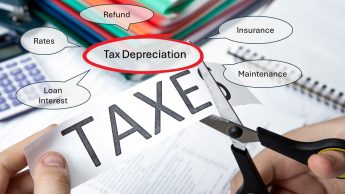Maximizing Returns: The Benefits of Claiming Tax Depreciation for Property Investors
Expert Contribution: Bradley Beer (B. Con. Mgt, AAIQS, MRICS, AVAA) is the Chief Executive Officer of BMT Tax Depreciation
As a property investor, optimising your returns is a top priority. One of the most effective strategies to boost your investment profitability is by claiming tax depreciation. This powerful financial tool allows you to reduce your taxable income by accounting for the wear and tear on your property over time.
Tax season can be overwhelming for many people, yet for property investors, it offers a chance to regain a portion of the expenses related to owning and managing an investment property. By implementing effective strategies and optimising deductions, investors can benefit greatly when it comes to filing their tax returns.
1. What is depreciation?
Depreciation is the natural wear and tear of an income-producing property and the assets within it. Depreciation is claimable on the building’s structure and permanent assets as well as the easily removable and mechanical assets.
Depreciation is the second largest tax deduction available to property investors after investment loan interest, yet it is commonly missed. Additionally, no cash needs to be outlaid to claim depreciation.
2. Benefits of Tax Depreciation
Here’s how leveraging tax depreciation can benefit property investors:
Significant Tax Savings
Claiming depreciation can lead to substantial tax savings. By reducing your taxable income, you pay less in taxes, leaving more money in your pocket. This can be especially beneficial for high-income investors who face higher tax brackets.
Increased Cash Flow
By claiming depreciation, investors can reduce their taxable income, which leads to lower tax obligations and increased cash flow. More cash flow means more money available for reinvestment or other financial needs.
Maximising Returns
Depreciation allows investors to maximise their returns by offsetting taxable income with deductions for the wear and tear of the property. This increases the overall profitability of your investment.
Long-Term Savings
Over time, depreciation can result in substantial tax savings, especially for properties with high depreciation values. These savings accumulate year over year, significantly enhancing your long-term investment strategy.
Property Value Maintenance
Depreciation deductions help investors cover the costs of maintaining and improving their properties, ultimately preserving their value. This ensures that the property remains attractive to tenants and retains its market value.
Investment Growth
By utilising tax depreciation, investors can potentially reinvest the tax savings into their properties, facilitating further growth and expansion of their real estate portfolio. This can lead to a cycle of increased property value and rental income.
3. Tips to maximising depreciation tax deductions
Australia’s leading tax depreciation specialists BMT Tax Depreciation recommend the following tips for maximising depreciation tax deductions.
a) Enlist the services of a specialist quantity surveyor
The first step to claiming depreciation is ordering a tax depreciation schedule.
A quantity surveyor specialising in tax depreciation will ensure that the maximum deductions are identified while maintaining Australian Taxation Office (ATO) compliance.
A BMT Tax Depreciation Schedule outlines all the depreciation deductions an investor can claim for their investment property. It lasts for forty years and the fee for preparing it is 100 per cent tax deductible. To request a tax depreciation quote for your property, visit Request an Australia-wide Quote | BMT Tax Depreciation (bmtqs.com.au)
b) Amend previous tax returns
Investors can amend two of their prior tax returns in order to recover any deductions that were previously overlooked or missed. This allows them to rectify any errors or omissions made in their tax returns by claiming the deductions they’re entitled to.
Claiming back missed deductions is not difficult, but it requires proper documentation for an accountant to ensure accurate processing and substantiate any retroactive claims. This highlights the significance of a tax depreciation schedule, as it serves as a crucial tool for maintaining records and supporting any claims that need to be made. By having a tax depreciation schedule in place, investors can effectively streamline the process and ensure that all missed deductions are appropriately addressed.
c) Claim partial year deductions
The ATO allows investors to claim depreciation based on the number of days a property was available for lease. This could occur if an investor has not owned an investment property for a full financial year, or they use their home as a holiday rental for part of the year.
d) Use techniques that maximise deductions sooner
There are depreciation rules and pools which allow property investors to claim tax deductions sooner, such as low-value pooling. A specialist quantity surveyor can determine which assets qualify for accelerated depreciation.
e) Claim for repairs, maintenance and renovations
Different rules apply to claiming repairs and capital improvements. The full cost of repairs can be claimed in the same financial year they are completed. An improvement, on the other hand, is when the condition of an item or property is improved beyond that of when it was purchased. Such improvements are capital in nature and must be depreciated over time.
It’s common for renovations to be completed by a previous owner which qualify for deductions for forty years from the construction completion date. This is why site inspections are important as only a trained eye, such as a quantity surveyor, can identify deductions and correctly estimate construction costs for depreciation.
4. Improve your immediate cashflow using a tax withholding variation
If you want to immediately improve your investment property cashflow, you can take advantage of a tax withholding variation. This reduces the amount of tax taken out of your pay, thereby increasing your immediate net income.
The steps involved in preparing your withholding variation are:
a) Tax Depreciation Report
The Quantity Surveyors report completed for your property will set out the depreciation schedule and capital allowance you can claim off your tax each year. To request a tax depreciation quote for your property, visit Request an Australia-wide Quote | BMT Tax Depreciation (bmtqs.com.au)
b) Submit all your rental property income and expenses to your tax accountant
Prepare a breakdown of rental income and expenses (including loan interest) for your investment property. Provide the Quantity Surveyors report and your breakdown of rental income and expenses to your Tax Accountant.
c) Request preparation of a tax withholding variation
Request your Tax Accountant to prepare a Tax Withholding Variation for you. This withholding variation allows you to reduce the amount of tax you pay from your regular salary. This tax reduction is then paid to you as a cash payment in your regular pay. Please see attached link to the ATO web site
https://www.ato.gov.au/forms/payg-withholding-variation-application/
How does the tax withholding variation work in practice?
After you have lodged your Tax Withholding Variation with the ATO, you will receive an official notice from the ATO which you can provide to your payroll officer for them to reduce the amount of tax that is taken out of your pay.
By doing the above you will end up with cash in your hand now, which makes it much easier to meet the monthly financial commitments for your investment property.
Conclusion
The first year of any property investment is always the hardest, because of the set-up costs and the deferred tax benefits. However, your property investment should become easier to manage over time and will hopefully become cash flow positive.
Disciplined financial management and maintaining a keen eye on the management of your property are critical ingredients for being a successful property investor.
Tax depreciation is a valuable tool for property investors aiming to maximize their returns and reduce taxable income. It’s important to consult with a tax professional or financial advisor to fully understand how tax depreciation can benefit your specific investment situation. Leveraging this strategy can significantly enhance your cash flow, long-term savings, and overall investment growth.
Contact Australia’s Leading Tax Depreciation Specialists
BMT Tax Depreciation conducts physical site inspections to ensure every available deduction, including previous renovations are identified and claimed accordingly.
Investors seeking to maximise the depreciation deductions within their investment property should call BMT on 1300 728 726 to have a chat or Request a Quote.






